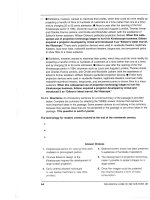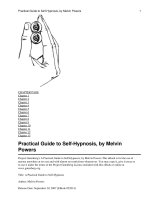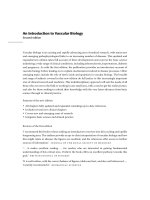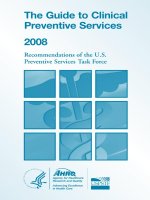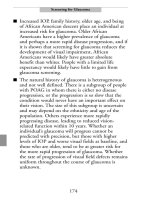A Practical Guide to Clinical Virology Second Edition - part 8 doc
Bạn đang xem bản rút gọn của tài liệu. Xem và tải ngay bản đầy đủ của tài liệu tại đây (633.81 KB, 29 trang )
29. EMERGING HEPATITIS VIRUSES
Other hepatitis viruses, non-A, non-B, non-C
G. L. Davis
Evidence that agents other than the commonly described hepatotrophic viruses
can cause hepatitis comes from the observation of multiple distinct episodes of
serologically uncharacterized hepati tis in some patients and the persistence of
some cases of post-transfusion hepatitis despite elimination of hepatitis B and
C from the donor pool. Additionally, most cases of non-A, non-B hepatitis are
also due to HCV.
THE AGENTS
Several viral agents have been identified recently but these are unlikely to cause
clinical liver disease. The ‘‘Hepatitis G’’ or ‘‘Hepatitis GB’’ is another
flavivirus-like virus with 20–30% sequence homologous to HCV. Though
probably transfusion transmitted, it is not felt to result in clinical disease and is
no longer felt to be a hepatitis virus. The SEN and TT viruses are common in
patients with hepatitis B and C, as well as the general population. Although
solid evidence that they cause hepatitis is lacking, it does appear that they may
be responsible for some cases.
TRANSMISSION/INCUBATION PERIOD/CLINICAL FEATURES
All 3 of the above-mentioned agents are common in trans fusion recipients and
patients with other forms of parenterally transmitted hepatitis, suggesting that
the routes of transmission may be similar. It still remains unclear how
prevalent these infections are and whether they account for an appreciable
proportion of patients, if any, with cryptogenic hepatitis and cirrhosis.
THERAPY
Interestingly, retrospective testing of HCV co-infected subjects has shown that
all 3 agents respond to interferon. Nonetheless, since liver disease as a result of
these infections has not been proven, treatment should not be considered.
LABORATORY DIAGNOSIS
The lack of widely available serological markers for these infections has
prevented identification of patients outside of research surveys. The studies
reported to date have screened serum samples with either RT-PCR
amplification of the viral RNA or an immunoperoxidase test to detect antibody.
201
FIFTH DISEASE?
A Practical Guide to Clinical Virology. Edited by L. R. Haaheim, J. R. Pattison and R. J. Whitley
Copyright
2002 John Wiley & Sons, Ltd.
ISBNs: 0-470-84429-9 (HB); 0-471-95097-1 (PB)
30. PARVOVIRUS B19
Human parvovirus, human serum parvovirus. Erythema infectiosum.
Slapped cheek disease. Fifth disease.
J. R. Pattison
Parvovirus B19 is a moderately contagious virus. The common result of
infection is erythema infectiosum (EI). When the virus infects individuals with
chronic haemolytic anaemia, aplastic crisis results.
TRANSMISSION/INCUBATION PERIOD/CLINICAL FEATURES
Transmission occurs by droplet inhalation. The interval between
exposure and EI is 2.5–3 weeks. Patients are infectious for approximately
7 days, commencing 1 week after acquiring infection. Patients with EI
are rarely infectious.
SYMPTOMS AND SIGNS
Systemic: Prodromes: Fever, Chills
Local: Rash, Arthropathy
Other: See Complications
The rash persists for up to 1 week, but may recrudesce. Arthropathy and
arthralgia may persist for weeks.
COMPLICATIONS
Aplastic crisis, fetal infection, chronic infection in the immuno-
compromised.
THERAPY AND PROPHYLAXIS
Intravenous immunoglobulin to control chronic infection in immuno-
compromised individuals. No vaccine.
203
LABORATORY DIAGNOSIS
In erythema infectiosum most patients have detect able IgM antibody at
presentation. Aplastic crisis patients present towards the end of the
period of viraemia. Virus is detectable in 60% of patients at presentation.
In the remainder IgM is detectable. In fetal infection, damage may not be
apparent until some weeks after maternal infection, thus detection of
IgM in maternal blood is infrequent. Fetal infection may only be
diagnosed by detection of virus in fetal blood or tissues.
204
Figure 30.1 PARVOVIRUS B19 (APLASTIC CRISIS, ERYTHEMA INFECTIOSUM)
CLINICAL FEATURES
SYMPTOMS AND SIGNS
Transmission is commonly by droplet inhalation. Rarely, the transfusion of
blood or blood products may lead to infection. At the peak of the viraemia, 1
week after exposure, there may be a mild flu-like illness with fever, chills and
malaise, lasting 2–3 days. In many cases infection occurs without further
symptoms. In erythema infectiosum the first sign is often marked erythema of
the cheeks (slapped cheek appearance). A faint pink macular or maculopapular
rash then develops on the trunk and limbs. As the rash fades a lacy or reticulate
pattern may emerge. Recrudescence is common, especially after bathing or
exposure to sunlight. In adult women symmetrical arthropathy is common
(80% of cases), involving ankles, knees, wrists and fingers. This is normally
resolved within 2–4 weeks. Low-grade fever may be present, and the rash may
be pruritic. Leukopenia, reticulocytopenia and thrombocytopenia occur.
Differential diagnosis. Other exanthems, especially rubella, also scarlet fever,
echovirus and coxsackievirus infections, and allergy. The diagnosis can only be
made with certainty by laboratory tests.
CLINICAL COURSE
The rash persists for 4–5 days, although recrudescence may occur over 1
month. Arthropathy in adults resolves in the majority within 2–4 weeks,
although in some arthralgia may persist for 2 months or so. Where arthritis
occurs in children it is rarely symmetric, and may be severe for 1–2 months.
COMPLICATIONS
Aplastic crisis. The cell receptor for parvovirus B19 is the P antigen present on
red blood cells, vascular endothelium and fetal myocytes. During all B19
infections, red blood cell precursors are infected in the bone marrow, causing a
transient arrest of erythropoiesis for 7–10 days. In patients whose red cells have
a shorter lifespan than normal, this arrest causes a rapid decrease in
haemoglobin to very low, sometimes life-threatening, levels. Such aplastic
crises occur in patients with hereditary haemolytic anaemias (e.g. sickle-cell
anaemia). Aplastic crisis is treated by transfusion of packed red cells to raise
haemoglobin levels.
Fetal infection. If infection occurs during pregnancy, the virus may cross the
placenta. This occurs in just under one-third of cases of maternal B19 infection.
In 90% of cases of maternal infection the pregnancy proceeds to term and to
date no defects have been noted in such ba bies. However, about 10% end in
spontaneous abortion in the second trimester (a 10-fold increase compared
205
with controls). Occasionally infection during pregnancy manifests as hydrops
fetalis.
Immunocompromised patients. Anaemia due to persistent infection may occur
in patients who are immunocompromised due to acute lymphatic leukaemia,
and HIV positivity.
THE VIRUS
Parvovirus B19 (Figure 30.2) is a single-stranded DNA virus of the genus
Parvovirus, family Parvoviridae. The cap sid is a naked icosahedron, 21 nm in
diameter for which the full three-dimens ional structure has been elucidated.
It is composed of two structural proteins
VP1 and VP2, the latter constituting
approximately 80% of the total protein
mass of the virus. The genome of B19 is a
single-stranded DNA 5.5 kb long. It ha s a
characteristic parvovirus structure with a
linear coding region bounde d at each end
by terminal palindromic sequences that
fold into hairpin duplexes. The virus
packages plus and minus DNA strands
into separate virio ns in approximately
equal proportions, but the coding regions
of B19 are confined to the plus strand.
There are two open reading frames both
driven by a single promotor at map
position 6.
There appears to be a single stable antigenic type of B19 so that infection is
followed by long-lasting immunity in an individual. However, genomic
variants do occur and these have been classified into a number of groups.
The groups do not correlate with the variety of clinical manifestations of B19,
but individual viruses in the groups cluster in time and geographically.
The virus cannot easily be propagated in tissue culture, although replication
occurs in primary cultures of human bone marrow. Virus replication requires
host-cell function(s) found in late S phase of cell division.
EPIDEMIOLOGY
B19 virus is transmitted by droplet inhalation. Patients are infectious for about
1 week, coinciding with prodromal illness. Case-to-case intervals vary between
7 and 14 days. Infection is most common in primary school children aged 5–13
years, among whom outbreaks may occur. Evidence of past infection is present
in 60–70% of adults. The virus is most common in the late winter and spring
months. Epidemics occur every 3–5 years. The virus occurs throughout the
world.
206
Figure 30.2 PARVOVIRUS
B19. Bar, 50 nm (Electron
micrograph courtesy of
M. J. Anderson)
THERAPY AND PROPHYLAXIS
Due to difficulty in propagating the virus in vitro, there is no vaccine. During
local epidemics, transfusion of packed erythrocytes or the administration of
normal human immunoglobulin may afford some protection to individuals at
risk of aplastic crisis. There is no indication for termination of pregnancy if
maternal infection occurs, since no abnormalit ies have been noted in babies
born to mothers whose pregnancy has been c omplicated by B19 infection. The
symptoms of B19 infection may be treated as appropriate: erythrocyte
transfusion for aplastic crisis, calomine lotion for pruritic rash, anti-
inflammatory agents for arthritis. Intravenous immunoglobulin is effective in
controlling chronic infection in the immunocompromised.
LABORATORY DIAGNOSIS
Erythema infectiosum. In the majority of cases specific IgM is present at the
onset of the rash. This may be detected by antibody capture RIA or ELISA.
Where the acute serum contains no detectable IgM, either a second sample
taken 10 days later should be simila rly examined, or the acute sample examined
for virus (see below).
Aplastic crisis. Sera taken within 3 days of the onset of symptoms are likely to
contain virus. Virus antigen may be detected by RIA or ELISA. Virus may also
be detected by hybridization to cloned viral DNA labelled with biotin or
32
P.
RIA, ELISA and DNA hybridization give positive results in 60% of acute sera
from cases of aplastic crisis; this figure falls to 30% if CIE and/or electron
microscopy are used.
Fetal infection. Diagnosis can only be made by examination of fetal material. It
is most useful to test fetal blood for virus antigen or DNA, since the fetus may
be too immature to synthesize IgM. DNA extracted from fetal tissue is tested
by DNA hybridization for viral genome. Alternatively, formalin-fixed paraffin-
embedded tissue may be examined for viral DNA by in situ hybridization.
207
A STEP IN THE WRONG DIRECTION?
A Practical Guide to Clinical Virology. Edited by L. R. Haaheim, J. R. Pattison and R. J. Whitley
Copyright
2002 John Wiley & Sons, Ltd.
ISBNs: 0-470-84429-9 (HB); 0-471-95097-1 (PB)
31. RETROVIRUSES
re ¼ reverse; tr ¼ transcriptase.
A. B. Dalen
Retroviruses are widely distributed throughout the vertebrates and perhaps the
invertebrates. The main characteristics of this group of viruses is the presence
in all infectious virions of an enzyme, reverse transcriptase, which catalyses the
formation of a complementary DNA strand to an RNA template. A double-
stranded DNA copy of the viral RNA genome (proviral DNA) may then be
integrated and propagated in the host-cell genome. The chemical, physical and
structural properties of the retroviruses from different species are essentially
similar.
Retroviruses are enveloped RNA viruses, 80–100 nm in diameter. Most
retroviruses carry surface glycoprotein spikes, anchored to the interior by a
transmembrane protein or glycoprotein. The loosely arranged interior core
contains a major and several minor proteins (the gag proteins). The viral
genome consists of two identical strands of RNA to which reverse transcriptase
is bound. The plasticity of the genome readily allows retroviruses to adapt to
selective pressure. Point mutations occur with the same frequency as in other
RNA viruses, but retroviral genomes recombine at an exception al rate with
other viral genes or host-cell sequences.
Endogenous retroviruses or retrovirus genomic material (retrogenes) are
normal constituents of cells and are inherited as Mendelian elements. They
may be expressed under certain circumstances as complete, infectious virus
particles (exogenous retroviruses). Mostly, however, the gene sequence
contains deletions and therefore remains unexpressed or gives rise to
incomplete particles. Endogenous retroviruses are mostly animal viruses
which may be ‘rescued’ when the cell is stressed in some way.
Exogenous retroviruses comprise three subfamilies:
. Oncovirinae (RNA tumour virus group). These are further subdivided on
morphological criteria into: (a) intracellular A-particles, (b) B-type
retroviruses (mouse mammary tumour virus), (c) C-type retroviruses
(leukaemia viruses HTLV-1 and 2) and (d) D-type retroviruses (associated
with primate neoplasias).
. Lentivirinae (slow virus group). Lentiviruses are non-oncogenic and cause
chronic, inflammatory disorders in the host. HIV-1 and 2 are related to this
group.
. Spumavirinae (foamy virus group). Spumavirus has been isolated from many
species, including man, and has no known pathogenic potential.
209
MODE OF INFECTION AND DISEASE MECHANISMS
Retroviruses have generally low infectivity, and transmission under natural
conditions usually requires intimate contact with blood, sperm, milk or
sputum. Retrovirus infections are often but not invariably permanent, and the
immune defence is in many systems inadequate to cope with the infection.
Many cell types may be infected within the host. Some cells propagate virus
without impairment of cellular function, while others may undergo malignant
transformation or present other signs of cellular dysfunction.
The latent period before disease develops is usually very long in retroviral
infections. Numerous organ systems may be afflicted, but the virus has a
predilection for lymphocytes (leukaemias and lymphocyte destruction) and the
central nervous system (chronic inflammatory diseas e). The mechanisms
underlying cellular dysfunction caused by retroviral infections are poorly
understood with the exception of acute transforming retroviruses.
Endogenous retroviruses have an aetiological role in certain neoplasias and
inflammatory disorders in animals. A similar function has not been clearly
demonstrated in the human counterpart.
210
A GLOBAL CHALLENGE
A Practical Guide to Clinical Virology. Edited by L. R. Haaheim, J. R. Pattison and R. J. Whitley
Copyright
2002 John Wiley & Sons, Ltd.
ISBNs: 0-470-84429-9 (HB); 0-471-95097-1 (PB)
32. HUMAN IMMUNODEFICIENCY
VIRUS (HIV)
AIDS ¼ acquired immune deficiency syndrome. Fr. SIDA.
B. A
˚
sjo
¨
AIDS is the end-stage manifestation of human immunodeficiency virus (HIV)
infection. Earlier phases of the infection are asymptomatic, persistent
generalized lymphadenopathy (PGL), HIV-related symptoms and constitu-
tional or neurological manifestations.
TRANSMISSION/INCUBATION PERIOD/CLINICAL FEATURES
Transmission is by sexual intercourse (especially homosexual) and by
inoculation of infectious blood or blood products. The virus can be
transmitted from mother to child, transplacentall y, during birth or via
breast feeding. Time from exposure to HIV until onset of acute clinical
illness is 1–4 weeks. After primary infection there is a period ranging
from a few months to more than 10 years with no or mild symptoms
before the appearance of severe immunodeficiency. The patient is
infectious before appearance of antibodies and remains so.
SYMPTOMS AND SIGNS
‘Primary infection’: Influenza- or Mononucleosis-like,
Erythematous Maculopapular Rash
HIV-related symptoms: Canidida, Dermatological Symptoms,
Varicella-Zoster
Constitutional symptoms: Fever, Night Sweat, Fatigue
AIDS: Opportunistic Infections, Kaposi’s
Sarcoma, Neuropathy, Dementia,
Tuberculosis
The average survival time after the diagnosis of AIDS has been made is
about 1 year if no antiviral therapy is given.
213
THERAPY AND PROPHYLAXIS
Various antiretroviral combination therapies are beneficial. There is no
specific immunoglobulin or vaccine. Both clinical trials and clinical
practice have convincingly demonstrated a significant reduction in
mother-to-child HIV transmission if zidovudine is given as prophylaxis
during pregnancy or nevirapine is given as a single-dose during delivery.
LABORATORY DIAGNOSIS
Specific antibodies appear 2–4 weeks to 3 months after infection and
remain for life. Viraemia is detected at high levels before seroconversion.
It is present at moderate levels during the clinically asymptomatic period.
Low numbers of CD4+ T-cells in the blood are characteristic but not
pathognomonic of HIV-associated immunodeficiency.
214
Figure 32.1 HUMAN IMMUNODEFICIENCY VIRUS (HIV INFECTION
DEVELOPING INTO AIDS)
CLINICAL FEATURES
A clinical staging and classification system for HIV disease has been worked
out by the Centers for Disease Control and Prevention, USA.
CATEGORY A includes:
Acute infection resembling mononucleosis or influenza with an erythematous
maculopapular rash that may be seen in about 50% of cases 1–4 weeks after
infection. Aseptic meningitis and encephalopathy, have been descri bed in some
cases. These acute manifestations are self-limited, but the HIV infection is
persistent and chronic disease manifestations may develop later. The
differential diagnosis includes primarily similar syndromes caused by EBV,
CMV and Toxoplasma gondii.
Asymptomatic HIV infection, is defined as the time when the presence of HIV
only can be demonstrated by laboratory analyses.
Persistent generalized lymphadenopathy (PGL), defined as swollen lymph nodes
(at least 1 cm in diameter) in two or more non-contagious extra-inguinal sites,
persisting for at least 3 months in the absence of any other illness or medication
known to cause enlarged nodes. The lymphadenopathy may be associated with
other manifestations of chronic HIV infection.
CATEGORY B consists of symptomatic conditions:
HIV-related clinical symptoms are indicative of a defect in cell-mediated
immunity and often manifest as candidiasis (oral thrush), seborrhoeic dermatitis,
hairy leukoplakia, yellow nails (fungus) and multidermatomal varicella-zoster.
Constitutional symptoms such as fever, diarrhoea, night sweat, fatigue and
malaise can be seen in patients lacking criteria for AIDS definition. The term
‘slim disease’ is used in certain African countries for chronic HIV infections.
Neurological diseases (myelopathy and peripheral neuropathy) caused by
HIV are seen in some patients lacking criteria for AIDS. In about 25% of
patients a subacute encephalitis termed AIDS-dementia complex is manifested.
Cerebral toxoplasmosis is here an important differential diagnosi s.
CATEGORY C includes clinical conditions listed in the AIDS surveillance
case definition:
AIDS is the term reserved for a person with at least one life-threatening
opportunistic infection or Kaposi’s sarcoma, with no identifiable reason for
profound immunodeficiency and having a positive test for HIV infection. The
average time to AIDS is 7–11 years if no therapy is given.
215
The most common opportunistic infections are pneumonia caused by
Pneumocystis carinii, typical and atypical mycobacterial infections, often
located extrapulmonary and disseminated, candida oesophagitis and severe
HSV and varicella-zoster virus infections. AIDS patients may also present with
severe wasting and the other symptoms and signs seen in HIV infections in
general, including AIDS-dementia. AIDS inevitably leads to death in the
course of less than a year in untreated cases.
THE VIRUS
HIV (Figure 32.2) is a complex RNA virus of the genus Lentivirus within the
Retroviridae family. The virus is an approximately 100 nm icosahedral structure
with 72 external spikes that are formed by the two major envelope glycoproteins
gp120 and gp41. The lipid bilayer is also
studded with a number of host-cell
proteins during the budding process. HIV
has a characteristic dense, cone-shaped
nucleocapsid composed of the core
protein p24. This nucleocapsid harbours
two copies of the 9.8 kb single-stranded
RNA genome which are associated with
the viral enzymes reverse transcriptase
(RT), RNase H, integrase and protease.
In addition to structural genes HIV has
genes whose products contribute to the
complex regulation and replication of the
virus. Of particular inter est is the Nef
(negative factor) protein. Deletions and
mutations of this protein have been found
in some HIV-infected individu als charac-
terized as long-term non-progressors. Two major types of the AIDS virus, HIV-
1 and HIV-2, have been identified. The major serological differences reside in
the surface protein gp120. HIV-1 and HIV-2 are further separated into subtypes
or ‘clades’ due to the marked varia bility in the V3 (variable region) of the gp120
protein. Infectivity is destroyed by most common disinfectants (hypochlorites,
glutaraldehyde) and by heat.
EPIDEMIOLOGY
AIDS was identified as a new disease entity in 1981 in the USA. The disease
spread rapidly, first in the urban population on the east and west coast, later to
all parts of the country and to other continents. Although the incidence of AIDS
in the homosexual population has received great public attention and still
accounts for the majority of AIDS cases in the USA and in Western Europe,
worldwide heterosexual transmission is the leading route for the HIV pandemic;
216
Figure 32.2 HUMAN
IMMUNODEFICIENCY VIRUS.
Bar, 100 nm (Electron micro-
graph courtesy of D. Hockley)
in particular contacts with prostitutes, bisexual men and intravenous drug users.
Sub-Saharan Africa, India, Thailand, the Russian Federation and China
represent epidemic hot spots with rapidly increasing HIV prevalence. HIV is
also transmitted from mother to child, in utero, intrapartum or perinatally via
breast feeding. Transmission via whole blood or blood products has virtually
ceased in industrialized countries after the introduction of blood screening.
However, this is still a major concern in developing countries.
HIV-2 has been found in West Africa and in persons with sexual contact
with West Africans. However, HIV-2 infections have been increasing rapidly in
India. Interestingly, the disease process is slower than for HIV-1.
The total number of individuals living with HIV by the end of the year 2001
was reported by the World Health Organization to be 40 million. Of these,
25 million (70%) are living in sub-Saharan Africa. During the the year 2001 it
was estimated there were 1600 new HIV infections per day worldwide, which
corresponds to 10 infections per minute.
THERAPY AND PROPHYLAXIS
No curative therapy for HIV infection is available. Both clinical trials and
clinical practice have convincingly demonstrated a significant reduction in
mother-to-child HIV trans mission if zidovudine is given as prophylaxis during
pregnancy or nevirapine is given as a single-dose during delivery. Prophylaxis
against AIDS-defining P. carinii pneumonia (PCP) has considerably
improved the quality of life and prolonged the time before AIDS is
diagnosed.
The introduction of the combination antiviral therapy regimens that contain
at least one protease inhibitor with two reverse transcriptase inhibitors (see
Chapter 4) has had a striking impact on AIDS lethality, with a dramatic
decrease in the frequency of opportunistic infections. Though many patients
experience improvements in quality of life with this therapy, there are severa l
concerns with it. In particular, difficulties for many patients to adhere to the
demanding drug dose schedules, side-effects, toxicities, development of
multiresistant viruses and drug interactions. A key issue of intensive antiviral
chemotherapy is to what extent the immune abnormalities induced by HIV can
be reversed by efficient viral suppression and how long the beneficial effects last
until eventual AIDS diagnosis. Guidelines for antiviral chemotherapy of HIV-
infected adults, children and pregnant women have been published by the
Department of Health and Human Services, USA and the British HIV
Association.
No vaccine is available against HIV infection. A number of potential HIV
vaccine candidates are under clinical trials. The obstacles are still numerous
with respect to choice of vaccine strain, efficacy, target groups and behavioural
changes among the vaccinees. At the present time the only effective prophylaxis
is intensive, widespread and persistent information on the modes of
transmission of HIV infection and risk-associated behaviour.
217
LABORATORY DIAGNOSIS
Tests to identify HIV infection can be divided into different categories: virus
cultivation, antigen detection and viral genome amplification (PCR). Virus can
be isolated from infected persons in most phases of the infection. Peripheral
blood mononuclear cells (PBMC) can be co-cultivated with activated PBMC
from HIV-negative donors in the presence of IL-2. A positive result is
recognized by appearance of virus antigen (p 24) or reverse transcriptase
activity in the culture medium.
Antibodies usually become detectable from 3 to 12 weeks after infection. As
a rule, an infected person remains antibody-positive for life, but antibody titres
often fall in patients with AIDS. The most widely applied tests are the indirect
and the competitive ELISA, using mostly a mixture of viral antigens. It is
recommended that confirmatory tests are carried out to exclude the possibility
of false positive resul ts. These are either variations of ELISA tests or Western
blot analysis of antibody specificity.
The PCR technique represents a major advance in the diagnosis of HIV
infection. This powerful technique can amplify target DNA present in minute
amounts. It is therefore useful for early detection of HIV in infants born to
infected mothers, since the presence of matern al IgG antibodies excludes
serological testing during the first months after birth. Quantitative determina-
tion of plasma viraemia (virion RNA) by reverse transcription PCR (RT-PCR)
has become a major tool to follow the progression of HIV infection in
untreated patients and to monitor the effects of antiviral chemotherapy in
patients.
A hallmark of chronic HIV infection is the depletion of CD4+ lymphocytes
and loss of these cells is closely associated with acqu isition of the characteristic
opportunistic infections. The monitoring of CD4+ lymphocyte count is
therefore an important determinant for clinical staging, initiation of antiviral
therapy and PCP prophylaxis. However, the present knowledge that HIV is
actively replicating in lymphatic organs throughout the infection raises the
question of whether the peripheral blood, containing 2% of the total T-cell
population, gives a representative picture of the pathogenic process. Plasma
viraemia, together with CD4 counts, has therefore come to play a more
important role in deciding when to initiate antiviral therapy.
218
ANOTHER ONE TO BE CHECKED?
A Practical Guide to Clinical Virology. Edited by L. R. Haaheim, J. R. Pattison and R. J. Whitley
Copyright
2002 John Wiley & Sons, Ltd.
ISBNs: 0-470-84429-9 (HB); 0-471-95097-1 (PB)
33. HUMAN T-CELL LYMPHOTROPIC
VIRUS TYPE I AND II
R. Whitley and G. Shaw
Human T-cell lymphotropic virus type I and II (HTLV-I and HTLV-II) are
two known human transforming oncogenic retroviruses.
TRANSMISSION/INCUBATION PERIOD/CLINICAL FEATURES
HTLV-I has a low infectivity and is transmitted vertically from mother
to child and horizontally by blood transfusions, intravenous drug abuse
or sexually. Transmission by drug abuse of HTLV-I and HTLV-II is an
increasing problem in many areas. HTLV-I exists in striking clusters in
Japan, central and South America, Africa and the Caribbean Islands. The
virus is rare outside the endemic areas. Clinical manifestations of early
infection have not been delineated, although cutaneous manifestations
and febrile disease have been reported. A few infected individuals (1 in
2000 to 1 in 100) develop adult T-cell leukaemia (ATL) after an average
interval of 30 years.
SYMPTOMS AND SIGNS
HTLV-I: Associated with Chronic Neurological Disease
(HAM/TSP) and Adult T-Cell Leukaemia (ATL)
HTLV-II: Not Yet Associated with Disease in Man
The typical aggressive form of ATL shows lymphadenopathy and frequent
cutaneous and visceral involvement. An atypical, more indolent form of
the disease has recently been reported.
Chronic progressive myelopathy (tropical spastic paraparesis, HTLV-
associated myelopathy) has been identified as another clinical manifes-
tation appearing with a low prevalence in HTLV-I seropositive individuals.
Myelopathy and ATL very rarely coexist in the same patient. Variations
in neurotropism of HTLV-I have been suggested. Host factors contri-
buting to the development of myelopathy have not been identified.
221
COMPLICATIONS
See above.
THERAPY AND PROPHYLAXIS
No specific therapy available. Screening of blood and organ donors for
antibody to HTLV-I has an impact on reducing seroconversions following
administration of these products.
LABORATORY DIAGNOSIS
There is extensive cross-reactivity between HTLV-I and HTLV-II. Thus
commercial ELISA tests cannot distinguish between these two ag ents.
The use of PCR to peripheral blood cells is being performed in research
laboratories.
222
CLINICAL FEATURES
SYMPTOMS AND SIGNS
No human disease has clearly been associated with HTLV-II, although it has
been isolated from a case of hairy cell leukaemia. However, most hairy cell
leukaemia cases are of B-cell phenotype. HTLV-I has been associated with
chronic neurological disease, tropic spastic paraparesis (TSP) or HTLV-
associated myelopathy (HAM), and adult T-cell leukaemia virus (ATL). Most
HTLV-I infections are subclinical. ATL is a disease of early adulthood, mostly
between the age of 20 and 30 years, appearing in approximately 1% of those
infected, presumably through perinatal infection.
ATL is associated with acute infiltration of skin and visceral tissue with
monoclonal proliferation of CD4 bearing T-lymphocytes. Clinical manifesta-
tions include skin lesions due to infiltrating leukaemic cells, interstitial
pneumonia, hepatosplenomegaly and bone lesions. The entity of HAM or
TSP is characterized by insidious onset and neurological findings of weakness,
spasticity of the extremities, hyperreflexia, positive Babinski’s sign, urinary and
faecal incontinence, impotence and mild peripheral sensory loss. The diseas e is
chronic and within 10 years 30% of patients are bedridden. Nevertheless,
cognitive function remains normal.
CLINICAL COURSE
ATL is invariably fatal. HAM or TSP, on the other hand, is associated with
progressive loss of neurological function.
COMPLICATIONS
Opportunistic infections are a common complication in individuals with ATL.
Similarly, a paraneoplastics syndrome characterized by increased bone
hypercalcaemia and lytic lesions is common.
THE VIRUS
HTLV-I and HTLV-II belong to the HTLV-BLV group within the Retroviridae
family, being distinct from HIV-1 and HIV-2 (Lentivirus). Like other RNA
retroviruses, the virion of HTLV-I consists of a viral envelope, an internal capsid
core, the viral reverse transcriptase enzyme and the viral negative-sense RNA.
The genomic structure of the integrated provirus DNA of HTLV-I and HTLV-II
consists of two regions and the terminal repeats, a gag gene, which encodes for
the internal core protein and the reverse transcriptase, followed by the envelope
genes, encoding the glycoproteins gp21 and gp46. The HTLV has two unique
genes (tax/rex; previously called X) coding for proteins activating transcription
223
of the virus and probably various cellular proteins, including the receptor for IL-
2. The development of ATL is a multistage process where HTLV-I is thought to
initiate the first step, appearance of T-lymphocytes with an abnormal
regulation of IL-2 receptors.
EPIDEMIOLOGY
Seroepidemiological studies of HTLV-I and HTLV-II show a geographical
clustering of cases with the highest prevalence in Southern Japan, the Caribbean,
Central Africa and the Southeastern USA. In Southern Japan, seroprevalence
rates approach 35%. In the USA and Europe the seroprevalence of both viruses
appears to be increasing in association with injected drug abuse and blood
transfusion. In the USA HTLV-I and HTLV-II infect 7–49% of injected drug
users. In the USA and Europe the viruses are most prevalent in intravenous
drug users, whereas in the Caribbean sexual transmission appears to be the
most common mode of spread; homosexually active men have a 5–10 times
higher prevalence rate than the general population (15% vs. 2%). In addition,
women who attend sexually transmitted diseases clinics and have other sexually
transmitted diseases, such as syphilis, have higher rates of infection.
In addition to intravenous drug abuse and sexual contact, transmission is
related to blood transfusion and breast feeding. A seroconversion rate of 63%
has been observed in recipients of cellular components of contaminated units
of blood. Recent data suggest that infection via breast milk is the primary route
of HTLV-I transmission in Southern Japan. Persons who are seropositive for
HTLV-I should be counselled regarding their inadequacy as blood and organ
donors.
THERAPY AND PROPHYLAXIS
At present there is no therapy for HTLV-I and HTLV-II infections, nor are
there currently any vaccines available. Introduction of routine screening of
blood and organ donors for antibody is decreasing seroconversion rates.
LABORATORY DIAGNOSIS
Serological assays and molecular biological assays are needed to confirm the
diagnosis of these oncoviruses. Commercial kits such as ELISA tests, Western
blot strips or reagents for agglutination tests make screening for HTLV-I
available. There is extensive cross-reactivity between HTLV-I and HTLV-II,
making it difficult to distinguish between these two viruses. Some laboratories
have developed viral peptides that will allow such distinction. Increasingly,
PCR methods are used to detect HTLV-I and HTLV-II in peripheral blood
and spinal fluid.
224
TICK BITES—A REAL PAIN
A Practical Guide to Clinical Virology. Edited by L. R. Haaheim, J. R. Pattison and R. J. Whitley
Copyright
2002 John Wiley & Sons, Ltd.
ISBNs: 0-470-84429-9 (HB); 0-471-95097-1 (PB)
34. TICK-BORNE ENCEPHALITIS
(TBE) VIRUS
Ger. Fru
¨
hsommer meningoenzephalitis ; Russ ian Spring–Summer (Eastern)
encephalitis, Central European (Western) encephalitis.
T. Traavik
TRANSMISSION/INCUBATION PERIOD/CLINICAL FEATURES
Man is infected by the bite of the tick Ixodes ricinus (in Eastern Europe
also Ixodes persulcatus), and consequently the disease is seen only in
areas infested by these vectors. Their distribution is restricted by climatic
conditions, vegetation and availability of host animals. TBE cases usually
occur between April and November. The disease is seen in many European
and Asian countries. Cases following consumption of infected, unpas-
teurized milk and cheese made from such milk are occasionally seen.
Interhuman virus transmission has never been reported. The incubation
time is 1–3 weeks, but may vary from 2 to 28 days. After milk-borne
exposure the incubation period is shorter, 3–4 days.
SYMPTOMS AND SIGNS
Primary phase: Moderate Fever, Headache, Myalgia
Secondary phase: Flushing of Face and Neck, Conjunctival Infection,
High Fever, Splitti ng Headache, Neck Rigidity,
Vomiting, Pareses
Elevated temperature 2–20 days in the secondary phase. The two phases
are usually separated by an afebrile and relatively asymptomatic period,
lasting 2–10 days. The Eastern TBE subtype usually progresses without
the intervening asymptomatic phase. Protracted convalescence is
commonly seen. Reported case fatality rates are 0.5–2.0% for the
Western and 5–20% for the Eastern subtype.
227
COMPLICATIONS
Chronic encephalitis with persistent CNS symptoms.
THERAPY AND PROPHYLAXIS
No specific therapy is available. Vaccines are available and have been
used with high efficacy. In enzootic/endemic areas clothing may be used
to avoid vector bites.
LABORATORY DIAGNOSIS
Serological diagnosis based on specific IgM detection is most practical
and reliable. PCR tests for detection of TBE virus RNA in blood and
CSF are being validated for clinical use.
228
Figure 34.1 TICK-BORNE ENCEPHALITIS VIRUS (ENCEPHALITIS)
